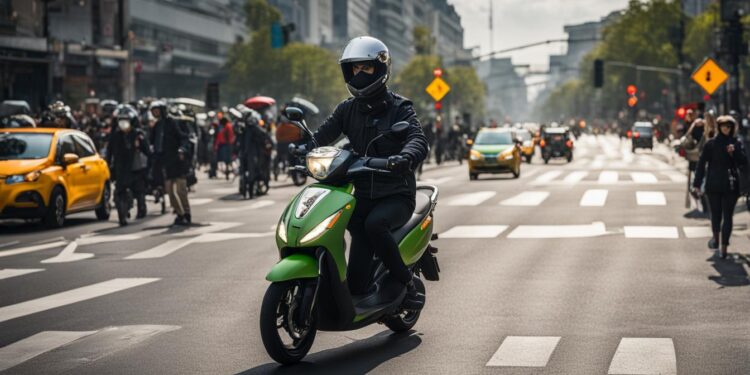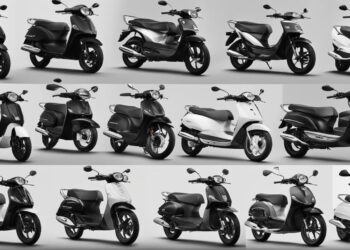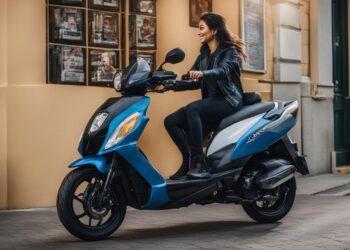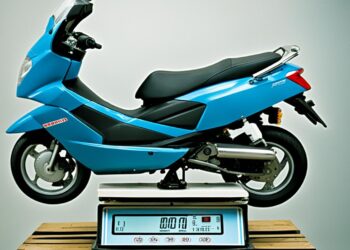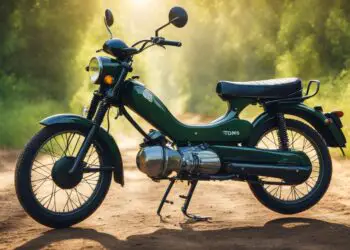I often get asked this question – are mopeds a safe mode of transportation for city commuting? The simple answer is that it depends on various factors, including safety features, rider behavior, and regulations. In this section, we will dive deeper into the safety aspects of using mopeds for city commuting and explore valuable safety tips for moped riders. We will also examine relevant accident statistics to give you a better understanding of the risks involved.
Mopeds are gaining popularity as an efficient and cost-effective means of transportation in urban areas. However, the safety risks associated with riding a moped cannot be ignored. It is essential to understand the factors that affect moped safety and take necessary precautions to mitigate those risks. Below are some moped safety tips that every rider should follow.
Key Takeaways:
- Moped safety depends on various factors, including safety features, rider behavior, and regulations.
- It is essential to understand the risks associated with moped usage and take necessary precautions to enhance safety.
- Moped riders should follow recommended safety tips to reduce the risk of accidents.
- Examining relevant accident statistics can help us understand the safety risks associated with moped usage.
- By following safety rules and regulations, moped riders can enjoy a safer and more efficient mode of transportation in the city.
Factors Affecting Moped Safety
When it comes to ensuring the safety of riders, various factors contribute to the overall safety of mopeds. From safety features incorporated in modern mopeds to regulations in place to ensure safe usage, moped safety depends on several factors:
Moped Safety Features
Mopeds come equipped with several safety features, such as a responsive braking system, durable tires, and a sturdy frame, all of which contribute to the safety of riders. Additionally, modern mopeds may have advanced features such as anti-lock brakes, electronic stability control, and traction control. These safety features provide riders with increased stability and control over the vehicle.
Moped Safety Regulations
In the United States, mopeds are subject to regulations that ensure safe usage and reduce the risk of accidents. These regulations vary from state to state and typically include rules regarding licensing, helmet usage, speed restrictions, and vehicle maintenance. For example, some states require moped riders to have a valid driver’s license or a moped-specific license, while others mandate the usage of helmets for all riders. Compliance with these regulations is essential in promoting moped safety and minimizing the risk of accidents on roads.
According to the National Highway Traffic Safety Administration, moped riders who wear helmets have a 29% lower risk of suffering fatal injuries in accidents than those who don’t wear helmets.
By understanding and adhering to moped safety features and regulations, riders can significantly reduce the risk of accidents and injuries. It is crucial to prioritize safety over convenience and take all necessary precautions to ensure a safe and enjoyable riding experience.
Benefits of Riding a Moped
When it comes to city commuting, there are many benefits of riding a moped. Let me share some of the advantages of using a moped over other modes of transportation:
- Cost-effectiveness: One of the most significant benefits of riding a moped is its affordability. Compared to cars or public transportation, mopeds are relatively inexpensive to own and operate. With the rising cost of living, every penny saved counts, and using a moped provides a great way to reduce expenses.
- Convenience: Mopeds are also incredibly convenient for getting around the city. They are agile and can easily maneuver through congested streets and narrow alleys, making them an excellent transportation option for those who need to navigate busy urban areas.
- Reduced Traffic Congestion: Riding a moped is an excellent way to reduce traffic congestion. With more people opting for mopeds, there will be fewer cars on the road, which means less traffic and less pollution. By choosing to ride a moped, you are contributing to the overall well-being of the community.
These are just a few of the many benefits of using a moped for city commuting. With the increasing popularity of mopeds, more and more people are discovering the numerous advantages they offer.
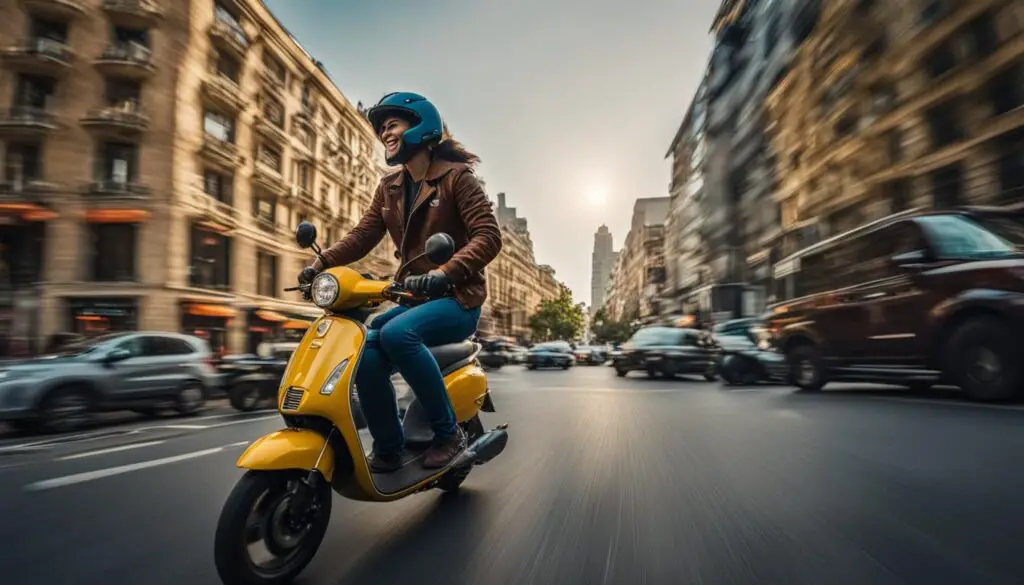
Moped Safety Gear and Precautions
As a moped rider, your safety should always be a top priority. Using proper safety gear and taking necessary precautions can significantly reduce the risk of accidents and injuries on the road.
Moped Safety Gear
When riding a moped, it is essential to wear proper safety gear, including:
- A certified helmet that meets safety standards
- Protective eyewear, such as goggles or a face shield
- A sturdy jacket and pants made of durable material
- Gloves made of non-slip material for a better grip on the handlebars
- Sturdy boots that cover the ankles and provide protection in case of a fall
Wearing this safety gear can help protect against potential injuries in the event of an accident.
Moped Riding Precautions
Aside from wearing proper safety gear, there are also several precautions moped riders should take to enhance their safety on the road:
- Be visible: Wear brightly colored clothing or reflective materials to increase visibility to other drivers.
- Stay alert: Always be aware of your surroundings and scan the road for potential hazards.
- Obey traffic laws: Follow all traffic rules and regulations, including speed limits, stop signs, and traffic lights.
- Keep a safe distance: Maintain a safe distance from other vehicles to avoid collisions.
- Signal your intentions: Use hand signals or turn signals to indicate your next move.
- Stay sober: Never operate a moped while under the influence of drugs or alcohol.
By following these precautions and wearing the proper safety gear, moped riders can enjoy a safer and more enjoyable ride.
Moped Safety Gear and Precautions
In this section, I will emphasize the importance of using proper safety gear when riding a moped and outline essential precautions that moped riders should take to enhance their safety on the road.
Wearing proper safety gear is critical when riding a moped. Here’s a list of gear that every moped rider should have:
- Helmet – A DOT-approved helmet is essential to protect your head in case of an accident. You should wear it every time you ride your moped.
- Eye protection – Goggles or a face shield can protect your eyes from debris, wind, and bugs.
- Gloves – Gloves can protect your hands from the elements and help you grip the handlebars better.
- Jacket – A durable jacket with elbow and shoulder padding can protect you from abrasions and impact.
- Pants – Pants made of durable material like leather or denim can protect your legs in case of a crash.
- Boots – Sturdy boots with a good grip can protect your feet and ankles.
In addition to wearing proper safety gear, here are some essential precautions that every moped rider should take:
- Inspect your moped before every ride. Check the brakes, lights, and tires to ensure they are in good condition.
- Follow traffic laws and regulations. Always obey traffic signals, signs, and speed limits.
- Stay visible. Wear bright clothing and use reflective tape on your moped to increase your visibility to other drivers.
- Avoid distracted riding. Don’t use your phone or other electronic devices while riding.
- Stay alert. Watch out for other drivers, pedestrians, and road hazards.
- Practice defensive driving. Anticipate other drivers’ actions and be prepared to take evasive action if necessary.
Maintenance Checklist for Moped Safety
Regular maintenance is essential for keeping your moped safe and roadworthy. Here’s a maintenance checklist that every moped owner should follow:
| Task | Frequency |
|---|---|
| Check tire pressure and tread depth | Weekly |
| Check brakes and brake fluid | Monthly |
| Check engine oil | Every 500 miles |
| Check spark plug | Every 1,000 miles |
| Adjust drive belt | Every 2,500 miles |
| Replace air filter | Every 3,000 miles |
| Clean carburetor | Every 5,000 miles or as needed |
| Replace fuel filter | Every 5,000 miles |
| Inspect and lubricate chain and sprockets | Every 5,000 miles |
Following this maintenance checklist can help ensure that your moped is in top condition, which can enhance its safety and reliability on the road.
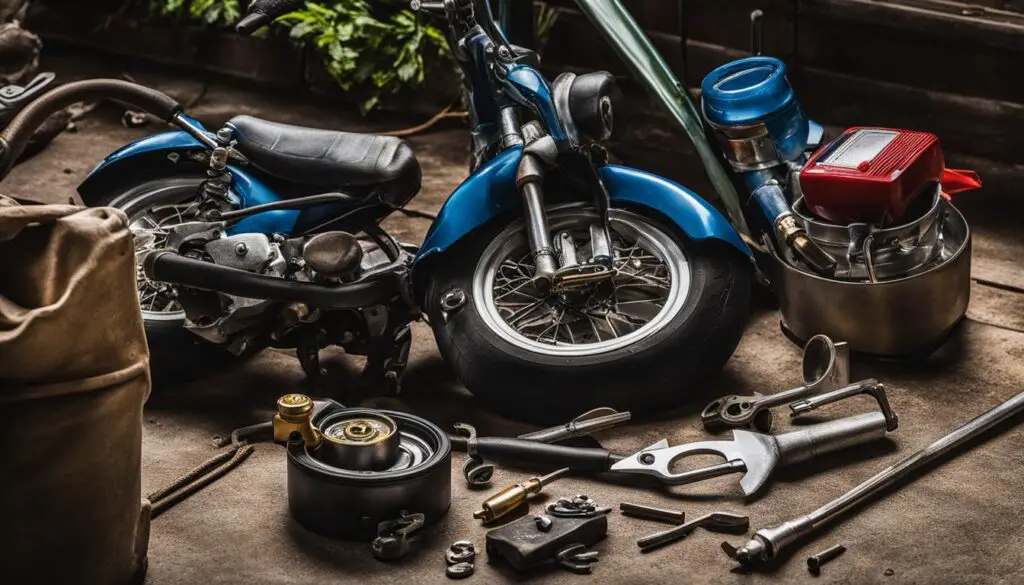
Moped Safety Rules and Regulations
As a moped rider, it’s essential to understand and adhere to the safety rules and regulations that govern moped usage. Below are some crucial safety rules and regulations to keep in mind:
- Age Limit: In the United States, the minimum age to ride a moped is 16 years old. Anyone under the age of 16 is not allowed to operate a moped on public roads.
- Moped Classification: Mopeds are classified as motorized bicycles and must meet specific requirements defined by the Department of Motor Vehicles (DMV). Riders should ensure that their mopeds meet these requirements and are registered with the DMV.
- Licensing Requirements: Many states require a valid driver’s license or moped license to operate a moped. Riders should check their state’s licensing requirements and obtain the necessary licenses before riding a moped.
- Helmet Laws: Helmet laws vary by state, but most states require moped riders to wear a helmet. Riders should ensure that their helmets meet the Department of Transportation’s safety standards and fit properly.
- Traffic Laws: Moped riders are required to follow the same traffic laws as other motor vehicles. This includes obeying traffic signals, using hand signals when turning, and staying within designated speed limits.
By following these safety rules and regulations, moped riders can help ensure their own safety and the safety of others on the road. Additionally, failure to follow these rules and regulations can result in legal consequences and fines.
“Safety is not an afterthought; it should be at the forefront of every moped rider’s mind. By following these safety rules and regulations, we can create a safer environment for everyone on the road.”
Understanding Moped Accident Statistics
While mopeds may offer a cost-effective and convenient means of transportation, it’s crucial to understand the potential safety risks associated with riding one. According to recent statistics, moped accidents are on the rise, particularly in urban areas where they are often used for commuting.
Between 2014 and 2018, there were over 11,000 moped accidents reported in the United States, resulting in 8,000 injuries and 700 deaths. These alarming numbers highlight the importance of adhering to safety regulations and taking precautionary measures when riding a moped.
The majority of moped accidents occur due to the following factors:
- Speeding
- Failure to yield
- Inattention or distraction
- Impaired driving
As the statistics show, the majority of moped accidents involve collisions with other vehicles, with nearly 70% of accidents occurring at intersections. Additionally, around 60% of moped accidents occur in urban areas, highlighting the importance of remaining vigilant when riding in busy city streets.
It’s essential to note that wearing proper safety gear, following recommended precautions, and adhering to safety rules and regulations can significantly reduce the risk of moped accidents. By doing so, riders can help ensure their safety on the road and enjoy the many benefits that come with using a moped for city commuting.
Conclusion
In conclusion, after exploring the safety aspects of using mopeds for city commuting, I have learned that safety should be a top priority for all moped riders. By understanding the factors that influence moped safety, such as the safety features incorporated in modern mopeds and the regulations in place to ensure safe usage, we can take adequate measures to enhance our safety on the road.
Following recommended precautions, such as wearing proper safety gear and performing regular maintenance tasks, is essential to ensure the safe operation of our vehicles. Additionally, by adhering to safety rules and regulations, we can promote safer and more efficient traffic flow for all road users.
Finally, by analyzing and understanding relevant moped accident statistics, we can gain a better understanding of the safety risks associated with moped usage for city commuting. With this knowledge, we can make informed decisions and take appropriate actions to protect ourselves and others on the road.
Overall, by prioritizing safety and following the guidelines and recommendations outlined in this article, moped riders can enjoy a safer and more efficient mode of transportation in the city.
FAQ
Are mopeds safe for city commuting?
Mopeds can be a safe mode of transportation for city commuting when used responsibly and with proper safety precautions in place. It is important for riders to be aware of their surroundings, follow traffic laws, and wear appropriate safety gear.
What are some moped safety tips?
Some important moped safety tips include wearing a helmet and other protective gear, obeying traffic laws, staying alert and focused while riding, avoiding distractions, and regularly maintaining your moped to ensure its proper functioning.
What are the factors affecting moped safety?
Several factors can influence moped safety, including the presence and effectiveness of safety features on the moped, the adherence to safety regulations and laws, the condition and maintenance of the moped, and the knowledge and behavior of the rider.
What are the benefits of riding a moped?
Riding a moped for city commuting can offer several benefits, such as cost-effectiveness in terms of fuel consumption and maintenance, easier maneuverability through traffic congestion, reduced parking space requirements, and being an environmentally friendly mode of transportation.
What safety gear and precautions should moped riders use?
Moped riders should wear a DOT-approved helmet, eye protection, gloves, and appropriate footwear. It is also important to dress in bright and visible clothing, follow traffic rules, avoid aggressive driving, and keep a safe distance from other vehicles on the road.
What should be included in a moped maintenance checklist?
A moped maintenance checklist should include regular inspections of tires, brakes, lights, signals, and fluids. It is also essential to keep the moped clean, lubricate moving parts, and address any issues or repairs promptly.
What are the safety rules and regulations for riding a moped?
Moped riders should familiarize themselves with local traffic laws and regulations. Generally, moped riders should have a valid driver’s license, operate within designated speed limits, use designated lanes where available, and follow all traffic signals and signs.
What do the moped accident statistics reveal?
Moped accident statistics demonstrate the importance of safe riding practices and the potential risks associated with moped usage. Understanding these statistics can help raise awareness and encourage riders to prioritize safety on the road.

